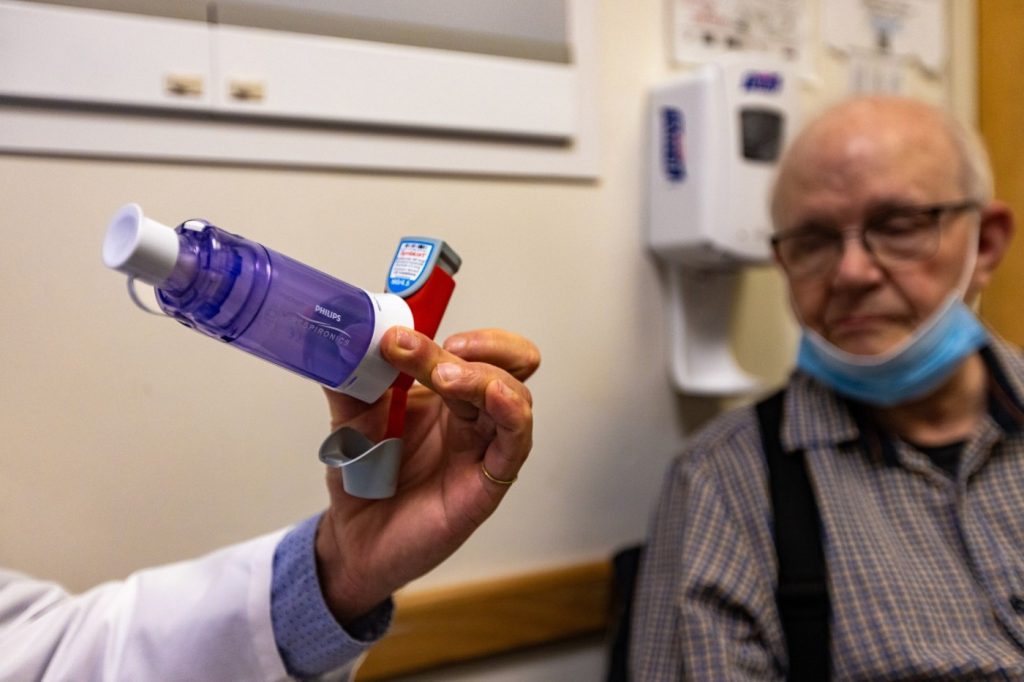Miguel Divo, a lung specialist at Brigham and Women’s Hospital in Boston, sits in an exam room across from Joel Rubinstein, who has asthma. Rubinstein, a retired psychiatrist, is about to get a checkup and hear a surprising pitch — for the planet, as well as his health.
Divo explains that boot-shaped inhalers, which represent nearly 90% of the U.S. market for asthma medication, save lives but also contribute to climate change. Each puff from an inhaler releases a hydrofluorocarbon gas that is 1,430 to 3,000 times as powerful as the most commonly known greenhouse gas, carbon dioxide.
“That absolutely never occurred to me,” said Rubinstein. “Especially, I mean, these are little, teeny things.”
So Divo has begun offering a more eco-friendly option to some patients with asthma and other lung diseases: a plastic, gray cylinder about the size and shape of a hockey puck that contains powdered medicine. Patients suck the powder into their lungs — no puff of gas required and no greenhouse gas emissions.
“You have the same medications, two different delivery systems,” Divo said.
Patients in the United States are prescribed roughly 144 million of what doctors call metered-dose inhalers each year, according to the most recently available data published in 2020. The cumulative amount of gas released is the equivalent of driving half a million gas-powered cars for a year. So, the benefits of moving to dry powder inhalers from gas inhalers could add up.
Hydrofluorocarbon gas contributes to climate change, which is creating more wildfire smoke, other types of air pollution, and longer allergy seasons. These conditions can make breathing more difficult — especially for people with asthma and chronic obstructive pulmonary disease, or COPD — and increase the use of inhalers.
Divo is one of a small but growing number of U.S. physicians determined to reverse what they see as an unhealthy cycle.
“There is only one planet and one human race,” Divo said. “We are creating our own problems and we need to do something.”
So Divo is working with patients like Rubinstein who may be willing to switch to dry powder inhalers. Rubinstein said no to the idea at first because the powder inhaler would have been more expensive. Then his insurer increased the copay on the metered-dose inhaler so Rubinstein decided to try the dry powder.
“For me, price is a big thing,” said Rubinstein, who has tracked health care and pharmaceutical spending in his professional roles for years. Inhaling the medicine using more of his own lung power was an adjustment. “The powder is a very strange thing, to blow powder into your mouth and lungs.”
But for Rubinstein, the new inhaler works and his asthma is under control. A recent study found that some patients in the United Kingdom who use dry powder inhalers have better asthma control while reducing greenhouse gas emissions. In Sweden, where the vast majority of patients use dry powder inhalers, rates of severe asthma are lower than in the United States.
Miguel Divo shows his patient, Joel Rubinstein, a dry powder inhaler. It has a much lower carbon footprint than a traditional inhaler while being equally effective for many patients with asthma. (Jesse Costa/WBUR/KFF Health News/TNS)
Rubinstein is one of a small number of U.S. patients who have made the transition. Divo said that, for a variety of reasons, only about a quarter of his patients even consider switching. Dry powder inhalers are often more expensive than gas propellant inhalers. For some, dry powder isn’t a good option because not all asthma or COPD sufferers can get their medications in this form. And dry powder inhalers aren’t recommended for young children or elderly patients with diminished lung strength.
Also, some patients using dry powder inhalers worry that without the noise from the spray, they may not be receiving the proper dose. Other patients don’t like the taste powder inhalers can leave in their mouths.
Divo said his priority is making sure patients have an inhaler they are comfortable using and that they can afford. But, when appropriate, he’ll keep offering the dry powder option.
Advocacy groups for asthma and COPD patients support more conversations about the connection between inhalers and climate change.
“The climate crisis makes these individuals have a higher risk of exacerbation and worsening disease,” said Albert Rizzo, chief medical officer of the American Lung Association. “We don’t want medications to contribute to that.”
Rizzo said there is work being done to make metered-dose inhalers more climate-friendly. The United States and many other countries are phasing down the use of hydrofluorocarbons, which are also used in refrigerators and air conditioners. It’s part of the global attempt to avoid the worst possible impacts of climate change. But inhaler manufacturers are largely exempt from those requirements and can continue to use the gases while they explore new options.
Some leading inhaler manufacturers have pledged to produce canisters with less potent greenhouse gases and to submit them for regulatory review by next year. It’s not clear when these inhalers might be available in pharmacies. Separately, the FDA is spending about $6 million on a study about the challenges of developing inhalers with a smaller carbon footprint.
Rizzo and other lung specialists worry these changes will translate into higher prices. That’s what happened in the early to mid-2000s when ozone-depleting chlorofluorocarbons (CFCs) were phased out of inhalers. Manufacturers changed the gas in metered-dose inhalers and the cost to patients nearly doubled. Today, many of those re-engineered inhalers remain expensive.
William Feldman, a pulmonologist and health policy researcher at Brigham and Women’s Hospital, said these dramatic price increases occur because manufacturers register updated inhalers as new products, even though they deliver medications already on the market. The manufacturers are then awarded patents, which prevent the production of competing generic medications for decades. The Federal Trade Commission says it is cracking down on this practice.
After the CFC ban, “manufacturers earned billions of dollars from the inhalers,” Feldman said of the re-engineered inhalers.
When inhaler costs went up, physicians say, patients cut back on puffs and suffered more asthma attacks. Gregg Furie, medical director for climate and sustainability at Brigham and Women’s Hospital, is worried that’s about to happen again.
“While these new propellants are potentially a real positive development, there’s also a significant risk that we’re going to see patients and payers face significant cost hikes,” Furie said.
Related Articles
Kelly Clarkson credits recent weight loss to medication, but not Ozempic
US Supreme Court denies California’s appeal for immunity for COVID-19 deaths at San Quentin prison
California moves closer to requiring new pollutant-warning labels for gas stoves
The surprising force stalling climate progress: California restaurants
Here’s a look at motherhood and pregnancy in the U.S.
Some of the largest inhaler manufacturers, including GSK, are already under scrutiny for allegedly inflating prices in the United States. Sydney Dodson-Nease told NPR and KFF Health News that the company has a strong record for keeping medicines accessible to patients but that it’s too early to comment on the price of the more environmentally sensitive inhalers the company is developing.
Developing affordable, effective, and climate-friendly inhalers will be important for hospitals as well as patients. The Agency for Healthcare Research and Quality recommends that hospitals looking to shrink their carbon footprint reduce inhaler emissions. Some hospital administrators see switching inhalers as low-hanging fruit on the list of climate-change improvements a hospital might make.
But Brian Chesebro, medical director of environmental stewardship at Providence, a hospital network in Oregon, said, “It’s not as easy as swapping inhalers.”
Chesebro said that even among metered-dose inhalers, the climate impact varies. So pharmacists should suggest the inhalers with the fewest greenhouse gas emissions. Insurers should also adjust reimbursements to favor climate-friendly alternatives, he said, and regulators could consider emissions when reviewing hospital performance.
Samantha Green, a family physician in Toronto, said clinicians can make a big difference with inhaler emissions by starting with the question: Does the patient in front of me really need one?
Green, who works on a project to make inhalers more environmentally sustainable, said that research shows a third of adults diagnosed with asthma may not have the disease.
“So that’s an easy place to start,” Green said. “Make sure the patient prescribed an inhaler is actually benefiting from it.”
Green said educating patients has a measurable effect. In her experience, patients are moved to learn that emissions from the approximately 200 puffs in one inhaler are equivalent to driving about 100 miles in a gas-powered car. Some researchers say switching to dry powder inhalers may be as beneficial for the climate as a patient adopting a vegetarian diet.
One of the hospitals in Green’s health care network, St. Joseph’s Health Centre, found that talking to patients about inhalers led to a significant decrease in the use of metered-dose devices. Over six months, the hospital went from 70% of patients using the puffers, to 30%.
Green said patients who switched to dry powder inhalers have largely stuck with them and appreciate using a device that is less likely to exacerbate environmental conditions that inflame asthma.
____
This article is from a partnership that includes WBUR, NPR, and KFF Health News.
(KFF Health News is a national newsroom that produces in-depth journalism about health issues and is one of the core operating programs of KFF — the independent source for health policy research, polling and journalism.)
___
©2024 Kaiser Health News. Visit khn.org. Distributed by Tribune Content Agency, LLC.


